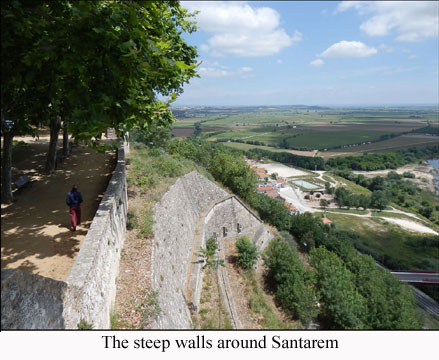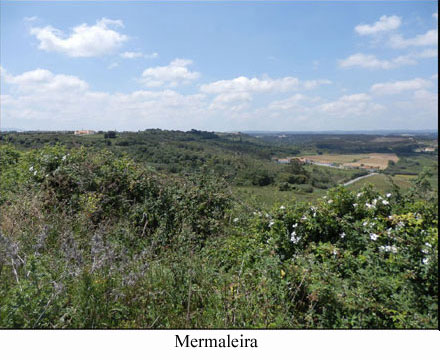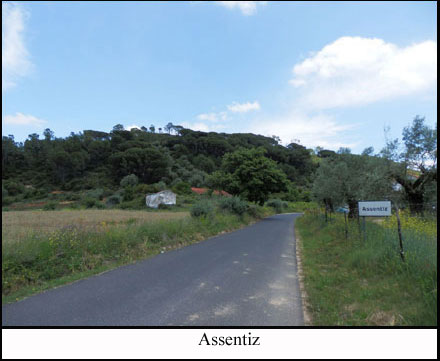|

Chapter 31
Massena's
Retreat to Santarem
Nov 1810 to March 1811
The
two armies faced each other across the 'Lines' for a month
until on November 14th under cover of a heavy mist Massena
withdrew north to a safer defensive position at Santarem.
The Lines had proved too strong for him to countenance
a frontal attack but he did consider that an eventual
flanking move down the Tagus might be feasible.
Once again Crauford’s Light Division and Pack’s
Brigade were at the forefront of Wellington’s advance
in pursuit of Massena. Pack’s orders on the 15th
November were to march the next day through Sobral and
Alemquer to join the Light Division in the neighbourhood
of Villa Nova and on the 18th Wellington was planning
to attack what he thought was Massena’s rear guard
as the following memorandum illustrates: |
 |
“If the
enemy should remain tomorrow morning in the position he
now occupies at and in front of Santarem, he is to be
attacked as follows. Br Genl Packs Brigade with Lt Col
Elders Battalion & half of the Brigade of Portugese
3 Pounders will form the left of the attack. This Column
will have its Light Infantry in front, & will be supported
by two squadrons of cavalry & will cross the two streams
at the bridges reconnoitred today by Lt Col Elder and
Br Genl Pack will drive in the Enemy’s Posts on
the heights between the Rivulets of the Great Hill of
Santarem and will thereafter and if possible prevent the
Enemy’s communication by the Great Road, with his
advanced Corps at the End of the causeway.
Br Genl Pack will move with his Right in front & he
will march before day light, in order to be at the Point
where he is to cross the Rivulet, by the time the Head
of Sir Brent Spencer’s Column will have arrived
near the out Posts at present occupied by the Light Division
on the Great Road. |
Br Genl Pack will communicate by his Right with the centre
attack. The right of the attack is to be formed by Col
Wynchs Brigade with Capt Ross’ Troop of Horse Artillery
and two Squadrons of Dragoons. The other brigade of the
Light Division and Two squadrons of Dragoons are to be
in Reserve in support of this attack. This column is to
take the same Road that was followed to day by the Patrol
of Cavalry under Lt Col Hervey & it will begin to
cross the Rivulet nearly at the same time that the Column
under Br Genl Pack begins to cross it higher up. He will
move on by the Road, followed today by the cavalry Patrol
until it arrives on the Height, in Rear of that occupied
by the Enemy’s Advanced Guard & between it and
the Great Hill of Santarem; this column will march by
its Right. |
|
The
above movements together with the advance of Lt Genl Sir
Brent Spencer’s Column along the high road will
probably occasion the Retreat of the Enemy’s advanced
Guard. Or if not Sir Brent Spencer will be enabled, to
attack the height which it occupies, without the risk
of sustaining any great loss.
Sir Brent Spencer will move against the Enemy along the
causeway, in Column; the Brigade of Infantry marching
by their left, the Brigade of Artillery, will accompany
the Column.
Sir Brent Spencer will leave one Brigade of his Division,
together with the German Legion in reserve on the Heights
at this End of the causeway. Half the Brigade of Portugese
3 Pounders is to be attached to this Reserve.
As soon as the Enemy’s advanced Guard retires, Col
Wynch’s Brigade will form on the Height behind that
ashief? it has quitted, throwing the left of the Brigade
towards the Great Road & communicating by the left
with
|
 |
Sir
Brent Spencer’s Division. Sir Brent Spencer’s
Division after having passed the causeway will form in
Columns of Battalions left in front.
Br General Pack’s Corps will be formed at the same
time, at some distance to the left of the 1st Division.From
this situation a further Distribution will be made for
the attack of the Great Hill of Santarem.
The Cavalry (with the exception of the Squadrons allotted
as above) and Captain Bulls Troop of Horse Artillery are
to be in Reserve on the right and left of the High Road
on this side the causeway, the Cavalry in Columns of Regiments.
M Genl Anson’s Brigade of cavalry has already been
directed to patrol the Road which ……….
from Rio Mayor to Santarem. The Brigade is to be put in
motion along that Road at day break tomorrow Morning.
It has to communicate by the right with Br Genl Pack as
soon as the latter has crossed the Rivulet.”
(signed)
Geo Murray
Cartaxo
Nov 18th 1810
However, heavy rain prevented the
action and subsequently Wellington found that his intelligence
was incorrect and that in fact Massena had his entire
army at Santarem and had he attacked he would have risked
serious defeat.
|
 |
On 24th November
Wellington ordered his troops to draw back and he established
his army winter headquarters at Cartaxo
with the whole army cantoned in the adjacent villages
except for the 5th Division which remained at Torres Vedras
and Craufords Light Division, Pack’s Portuguese
Brigade and Anson’s cavalry which as an advance
guard were left in touch with the French. Hill and Hamilton
remained south of the Tagus. Pack’s Brigade and
the Light Division remained in front of the French forces
at Santarem until the following March. Crauford took the
opportunity to take some home leave and was not back in
the Peninsular until the following May. His place was
taken temporarily by Major General Sir William Erskine,
whose reputation for incompetence and occasional bouts
of insanity, led him to be cashiered from the army in
1812. He eventually committed suicide in Lisbon in 1813,
by jumping out of a window. Massena in December 1810 was
in a most difficult position. Wellington’s strategy
which he had successfully kept secret |
had been
to construct the defensive lines around Lisbon, a work
he commenced a year earlier in October 1809; to train
the Portuguese army to a level that they could be integrated
into an allied fighting force; to train and organise the
Portuguese Militia to operate behind the enemy lines;
and to put into effect a scorched earth policy in front
of the advancing enemy so that they had very little to
survive on from the land they occupied. In addition, thanks
to the Royal Navy, he had secure supply lines, communications
with England, and continuing reinforcements, such that
by March 1811 he had 43,000 troops in the field not including
the militia. Massena on the other hand was isolated and
his power diminishing. His communications with France
were through hostile and guerrilla infested Portugal and
Spain such that when he sent messages to France it required
an escort of battalion strength together with dragoons.
He had entered Portugal in August with 65,000 men but
by December was down to 47,000 and those were underfed
and demoralised. In addition, what orders he did receive
from Napoleon were often misguided and unrealistic. So
it was to a large degree inevitable that Massena should
eventually retreat which he did on 6th March 1811 after
5 months in front of the ‘Lines’. |
Massena
remained at Santarem for the next 3 months with Wellington
in close touch on the north of the Tagus and General Hill
to the south of the Tagus guarding against the French
crossing and trying an outflanking movement. However,
Hill was taken seriously ill with fever at the end of
November and was replaced by Beresford who commanded a
semi independent corps south of the Tagus until Hill’s
return in June 1811. It is possible that this change in
command had a negative effect upon the organisation of
the Portuguese forces, who suffered badly from shortages
of provisions during the advance in March 1811.
The disposition of the allied forces in front of Santarem
was as follows: The three British cavalry brigades formed
a line at the front, reaching from Porto de Mugem on the
Tagus to Sao Joao de Ribiera on the upper Rio Mayor. The
infantry Divisions (apart from the 2nd Division) were
arranged in successive lines of cantonment behind them,
watching the course of the Rio Mayor, while the reserves
had retired as |
 |
far as
the Lines of Torres Vedras. On the right near the Tagus,
lay the Light Division, immediately in front of Santarem,
quartered in Valle and other villages. On the left the
front line was formed by Pack’s Portuguese who lay
at Almoster, Marmaleira
and Assentiz with 2 or 3 companies
at Joao Ribeira on the heights overlooking
the middle course of the Rio Mayor. In support of the
Light Division, but five miles to the rear, at Cartaxo
and other places, was the large and powerful 1st Division,
7,000 bayonets. The 4th Division lay at an equal distance
behind the 1st, at Azambuja and Aveiras da Cima. Behind
Pack, on the inland or Leira road, Picton and his 3rd
Division were placed at Alcoentre. Their support was the
5th Division at Torres Vedras in the old Lines, seventeen
miles to the rear, from which a circuitous road led to
Alcoentre. Finally, the newly formed 6th Division was
placed at the other end of the Lines, but just outside
them, at Alemquer and Arruda, with Le Cor’s Portuguese
Division, immediately behind at Alhandra. |
Maps
Photos
|
















